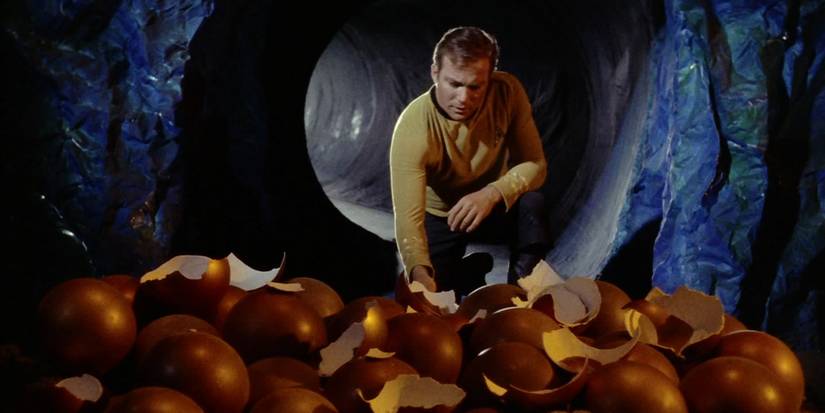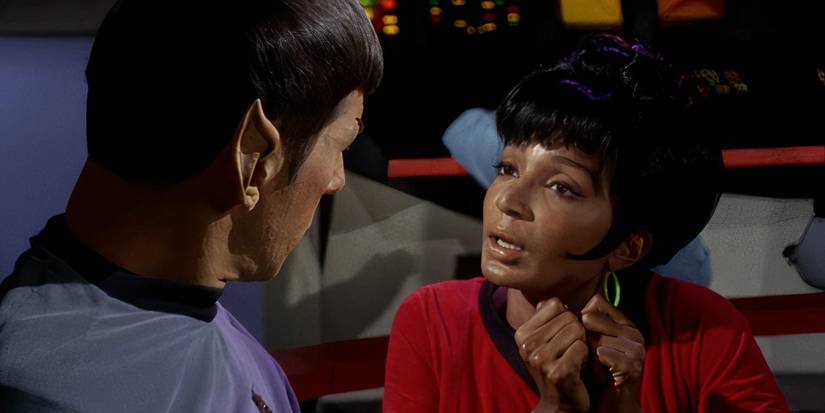
The first season of Star Trek: The Original Series features many well-known episodes like “Where No Man Has Gone Before,” “The Naked Time,” “Arena,” “Space Seed,” and “The City on the Edge of Forever.” However, “The Devil in the Dark” is a standout episode that often doesn’t get enough credit – it’s considered one of the best from the show’s first season and the entire original series from the 1960s.
Even William Shatner, who played Captain Kirk, and Leonard Nimoy both loved the “The Devil in the Dark” episode – Shatner called it his favorite in his 1993 autobiography, and Nimoy has spoken highly of it as well. Despite how good the episode is, though, it left out a very memorable character from the Enterprise.
Why “The Devil In The Dark” Is An All-Time Classic Star Trek Episode

As a huge Star Trek fan, I always come back to “The Devil in the Dark.” It seems like a pretty standard sci-fi story at first – a scary creature is seen as the enemy, but really needs understanding. While the idea of a misunderstood monster wasn’t totally new even back then – think Frankenstein! – what makes this episode so great isn’t the concept itself, but how it’s done. It’s brilliantly executed, and that’s what really sets it apart.
Few science fiction stories explore the idea of the “misunderstood monster” as well as Star Trek‘s “The Devil in the Dark,” and that’s largely thanks to the characters at its heart. The episode wisely shifts focus away from most of the usual crew to center on Captain Kirk, Spock, and Dr. McCoy. By this point in the series, the playful but competitive relationship between these three was well-known, and “The Devil in the Dark” perfectly highlighted their dynamic.
What makes “The Devil in the Dark” so clever is how it unexpectedly puts Spock in the role of the empathetic one. Usually the logical thinker, Spock is able to connect with the creature, the Horta, through a mind-meld, understanding its feelings. Meanwhile, the other characters, like McCoy and the miners, only see a dangerous monster. This shift in perspective is compelling and truly establishes Spock as a central, vital member of the Star Trek: The Original Series crew.
The story’s ethical dilemma creates truly challenging situations. Kirk uses his authority to order McCoy to save the Horta, despite initially trying to destroy it for most of the episode. The story also works as an environmental message, showing how disturbing a peaceful creature’s home can have consequences. Star Trek asks viewers to empathize with a seemingly monstrous being—and “The Devil in the Dark” succeeds because it’s so well-written.
“The Devil In The Dark” Needed Uhura

The 1960s Star Trek episode “The Devil in the Dark” is notable for an unfortunate reason: it’s the only episode in the series where no female characters have any lines of dialogue.
This Star Trek episode is a letdown because it largely ignores female characters, both among the Enterprise crew and the people needing rescue. While it’s a product of its time – the 1960s – The Original Series often presented women as simple characters needing help, and frequently focused on their appearance rather than their substance, like with the often-featured Orion dancers.
Despite the time it was created, Gene Roddenberry envisioned Starfleet as a society with true gender equality. So, the fact that episodes of the original Star Trek sometimes featured no female voices was not only unrealistic, but also went against the show’s own established world.
The problem was fixed, and although creating well-developed female characters still needed improvement, Star Trek: The Original Series made sure not to repeat the same mistake in later episodes.
Interestingly, the answer to fixing the lack of female representation in “The Devil in the Dark” was surprisingly obvious: Lieutenant Uhura.
It was common for supporting characters on the original Star Trek series to miss an episode now and then. For example, both Uhura and Sulu aren’t in “The Devil in the Dark.” However, since the entire plot of that episode revolves around a communication breakdown, it seems strange that Uhura – the Enterprise’s communications officer – wasn’t included.
Instead of Spock figuring out the Horta was friendly on his own, the story could have shown Uhura trying – and failing – to understand the creature’s sounds. She could then suggest to Spock that telepathy was the only way to communicate. This would have made the discovery a team effort between the science and communications departments, highlighting how both are important when encountering new alien life.
As we’ve discussed, “The Devil in the Dark” is strong because it centers on the dynamic between Kirk, Spock, and McCoy. The story really relies on their teamwork. However, bringing Uhura in as someone Spock could consult wouldn’t have hurt the episode’s success. In fact, having Uhura and Spock work together could have strengthened their relationship, which has become increasingly significant for fans of the original Star Trek series over the years.
Read More
- Pedro Pascal Set to Steer Avengers as Reed Richards in Shocking Marvel Shift!
- Ricky and Morty Star Harry Belden Thinks Season 9 Will Be Higher Quality Than Seasons 7 & 8
- How Will Smith Reached Out To Wanda Sykes After He ‘Overshadowed’ Her Oscars Hosting Gig By Slapping Chris Rock
- One Reason The Cancellation Of Stephen Colbert’s The Late Show Is ‘Incredibly Sad,’ According To John Oliver
- Screamboat 2 Confirmed: Minnie Mouse Joins Mickey Mouse Slasher Sequel
- Summer I Turned Pretty: Susannah’s Funeral Gains a Whole New Meaning In Season 3
- Золото прогноз
- Доллар обгонит чилийское песо? Эксперты раскрыли неожиданный сценарий
- Dylan Efron Was Asked About Momma Donna Kelce Joining Traitors, And There’s A Very Taylor Swift Reason He Thinks She Has Good Odds
- Прогноз нефти
2025-11-07 21:22